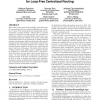Free Online Productivity Tools
i2Speak
i2Symbol
i2OCR
iTex2Img
iWeb2Print
iWeb2Shot
i2Type
iPdf2Split
iPdf2Merge
i2Bopomofo
i2Arabic
i2Style
i2Image
i2PDF
iLatex2Rtf
Sci2ools
CCR
2008
2008
Message-efficient dissemination for loop-free centralized routing
With steady improvement in the reliability and performance of communication devices, routing instabilities now contribute to many of the remaining service degradations and interruptions in modern networks. This has led to a renewed interest in centralized routing systems that, compared to distributed routing, can provide greater control over routing decisions and better visibility of the results. One benefit of centralized control is the opportunity to readily eliminate transient routing loops, which arise frequently after network changes because of inconsistent routing states across devices. Translating this conceptual simplicity into a solution with tolerable message complexity is non-trivial. Addressing this issue is the focus of this paper. We identify when and why avoiding transient loops might require a significant number of messages in a centralized routing system, and demonstrate that this is the case under many common failure scenarios. We also establish that minimizing the n...
| Added | 09 Dec 2010 |
| Updated | 09 Dec 2010 |
| Type | Journal |
| Year | 2008 |
| Where | CCR |
| Authors | Haldane Peterson, Soumya Sen, Jaideep Chandrashekar, Lixin Gao, Roch Guérin, Zhi-Li Zhang |
Comments (0)

